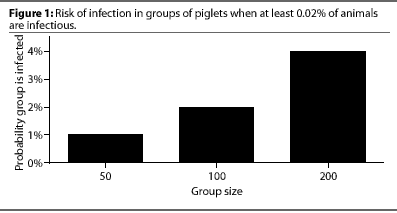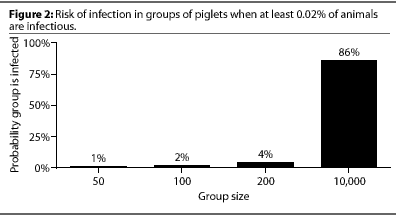What's your interpretation?
Non-refereed
Probability of infection of weaned piglets
This chart shows the approximate proportion of nursery groups that become infected with a pathogen that is infrequently infectious to piglets at weaning. What is the probability that a group of 10,000 weaned piglets is infected?

The probability of infection is approximately 86%, as shown in Figure 2.

If 1% of groups of 50 are infected (Figure 1), at least 0.02% of piglets are infectious, as the risk of group infection is
1-(1-(proportion infectious weaned piglets)n
where n is the number of piglets in the group.
A 0.02% level of infectious piglets translates to approximately 1%, 2%, 4%, and 86% of piglets in groups of 50, 100, 200, and 10,000 pigs respectively.
Though such a growth in risk is often assumed, it is not always quantified. The problem is that low group sizes have a low probability of detecting a risk, but large group sizes are difficult to use in studies. Furthermore, the increase in risk with increasedgroup size is almost invariably larger than that expected by lay personnel.
This relationship can be useful in determining segregated early weaning policies, especially for disease eradication. Increased risk of infection in large groups limits the scale of projects, or at least calls for subdivision of progeny from large sow units.
-- Submitted by John Deen, DVM
